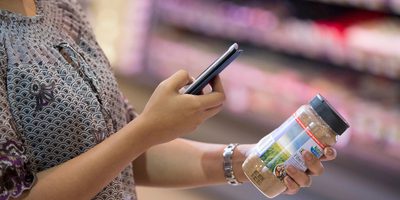
‘No added sugar’ rule is a good step – but study shows job’s not done
Australia’s food regulators must develop a comprehensive definition for added sugars in processed foods to enable consumers to make healthy choices, according to new research from The George Institute for Global Health, published today in Current Developments in Nutrition.1
In December, government agency Food Standards Australia New Zealand (FSANZ) announced tighter restrictions on voluntary ‘no added sugar’ claims that will mean products high in sugars can no longer make these claims - a positive step forward - but other important reforms must also proceed.2
“We recognise that Food Ministers and FSANZ needed to address the proliferation of potentially misleading ‘no added sugar’ claims in the market and commend them for adopting a pragmatic solution to that problem based on total sugar content,” commented Dr Alexandra Jones, Senior Research Fellow in Food Policy at The George Institute for Global Health and Conjoint Senior Lecturer in the Faculty of Medicine at UNSW Sydney, who is senior author of the new research.
“However, The George Institute is concerned that these changes to ‘no added sugar’ claims may delay or see abandoned the original purpose of FSANZ’s work on added sugars, which was to require the disclosure of added sugars in the nutrition information panel (NIP),” she said. “To enable this disclosure, a comprehensive definition of added sugars is needed, and we are calling on FSANZ to progress development and implementation of this definition.
“Without a comprehensive definition of added sugars in Australia, we are paving the way for highly processed, concentrated fruit and vegetable sugars to remain ‘hidden’ in foods that can still be presented by the food industry as ‘healthy’,” explained Dr Jones.
“A comprehensive definition is also an essential step to building added sugar considerations into other policy levers such as the Health Star Rating system, which will collectively and significantly drive reductions in consumption,” she said.
The George Institute’s new research published today explains the significance of what FSANZ counts as ‘in’ and ‘out’ of any potential added sugars definition. In the absence of an internationally agreed standard definition, the research tested three definitions of added sugar across 25,323 packaged products in the Australian food supply: the definition used by the United States United States Food and Drug Administration (US FDA)4, one developed by the World Health Organisation (WHO)5 and a third, more comprehensive definition developed by the Food Policy team at The George Institute.6
The new comprehensive definition included additional forms of sugars that have been linked with negative health impacts in the latest evidence, and ‘future proofs’ the definition as much as possible in anticipation of further industry innovation in added sugars. Excess intake of added sugars is associated with weight gain and increased risk of type 2 diabetes, dental cavities, and cancers including breast and bowel.3
Overall, the research found around 60 per cent of the Australian food supply contained added sugars of some kind, but the policy implications of adopting a broader definition were clear - the new comprehensive definition would capture and require added sugars to be disclosed on 7.4 per cent more products than the US FDA definition and 4.3 per cent more than the WHO definition.1
Under the new rule, a rolled fruit strap that can no longer claim to have ‘no added sugar’ can still claim to be ‘100% fruit’ or ‘made from real fruit’. This suggests the strap is as healthy as the whole fruit. After intensive heating and compression, however, the nutritional value in original fruits or vegetables, such as fibre and water, are removed, leaving only concentrated sugars.
“These processed fruit and vegetable sugars are found in popular foods – many targeting children – such as fruit straps, flavoured yoghurt pouches, infant foods, muesli bars and cereals. People are buying these products believing them to be healthy, when really, they are not,” said Jane Martin, Executive Manager of the Food for Health Alliance.
“If we do not include processed fruit and vegetable sugars in the form of pastes, powders, pulps and purees, as well as dried fruits, in a comprehensive definition of added sugars within the regulations, we are creating loopholes that can be exploited by the food industry,” she said.
To ensure Australians can be confident that they have robust protection from the harms of added sugars in policy settings, The George Institute is calling on Australian Food Ministers and FSANZ to:
- Build upon the progress in regulation of added sugars in the food supply
- Progress development and implementation of a comprehensive definition of added sugars to enable mandatory quantifying and disclosure of added sugars in nutrition information panels
- Build added sugar data into updates to the method used to calculate Health Star Ratings
WHO recommends children 2-18 years of age consumer less than 6 teaspoons, or 25 grams of sugar per day.7 A school lunch box containing one fruit flavoured yoghurt pouch, one muesli bar with dried fruit and one rolled fruit strap would on average meet or exceed this daily limit for total sugar.
References:
- Coyle, D.H. et al, 23 January 2024. ‘Assessing the policy implications of different definitions for ‘added sugars’: An analysis across the Australian packaged food and beverage supply.” Current Developments in Nutrition https://doi.org/10.1016/j.cdnut.2023.102058
- Food Standards Australia New Zealand, 1 December 2023, P1062 – Defining added sugars for claims
- BMJ 2023;381:e071609. Dietary sugar consumption and health: umbrella review
- U.S. Food and Drug Administration. Added sugars on the nutritional label
- World Health Organization. Sugars Factsheet
- Jones, A., Scapin T., ‘Supporting evidence-informed policy work on added sugar: A report commission for VicHealth 2020. The George Institute for Global Health
- World Health Organization. Guideline. Sugars intake for adults and children







